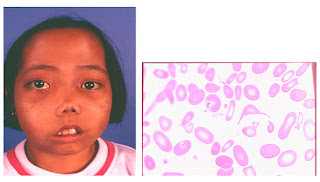
THALASSEMIA (Thalassemia) - Disease Blood Derivatives Thalassemia (
Thalassemia) is a blood disease inherited autosomal resesif or derived. In people with genetic defects causing thalassemia, the level of the formation of one of the chains-chains of globin chains that make up the hemoglobin becomes reduced. Synthesis of one chain of the globin chains can lead to the formation of the reduced molecule of hemoglobin which is abnormal, that causes anemia, as
symptoms typical of thalassemia that appears.People with
Thalassemia have a problem with the number of globin chains are synthesized too little, while "sickle cell anaemia (haemoglobin disorder or a hemoglobinopathy) is a qualitative problem of synthesis of globin chains that function is not correct. Thalassemia usually leads to the low production of protein-protein globin chains are normal. often through mutations in regulatory genes. Hemoglobinopathy (hemoglobin abnormalities) showed structural abnormalities in globin chains of the protein itself. Two conditions can occur from a phone, however, because most conditions menyebabka abnormality in protein-protein globin chains (hemoglobinopathy) also affects the outcome (
Thalassemia). Thus, some
thalassemia is a hemoglobinopathy, but mostly not. One or both of these conditions can cause anemia.
Thalassemia disease is very common among people of the Mediterranean, so the link is the history of geographical naming this
disease Thalassemia: Thalassa (such as) is the language of Greece to the sea, Haema (a?µa) is the language of Greece to the blood. Generally,
Thalassemia is common in the population which evolved in humid climates where malaria is endemic.
Thalassemia can strike all the races, the
incidence of thalassemia should be prevented from malaria because of the blood cells are easy degradation. In Europe, the highest concentrations of the disease is found in Greece and in Italy, in particular, Southern Italy and the bottom of the Valley of the Po. The major Mediterranean islands (except the Balearic) such as Sicily, Sardinia, Corsica, Malta, Cyprus and Crete is the most widely found
disease Thalassemia. Other Mediterranean people, as well as those around the Mediterranean, also have a high rate of people with
thalassemia, including the Middle East and North Africa. Much of the Mediterranean, South Asia is also quite a number of its victims, with the highest concentration of carrier in the world (18% of the population) reside in the Republic of Maldives. people with
Thalassemia classified according to the chain of the hemoglobin molecule which of his hit. In sufferers of a
thalassemia production chain a globin chains, which are exposed to, while in ß
Thalassemia production chain of ß globin chains him exposed.
Thalassemia produces a deficiency of a or ß globin chains, unlike sickle-cell disease (sickle-cell disease) that produce a specific mutant form of ß globin chains.
The chain of ß globin chains are encoded by a gene on chromosome 11; chain a globin chains are encoded by two closely related genes on chromosome 16. Thus, in a normal person with two copies of each chromosome, there are two loci encoding the ß chain, and four loci encoding the a chain. Omission of one of the a loci has a high prevalence in people of African or Asian descent, making them more likely to be afflicted by the a ß thalassemia. Thalassemia in general suffered by the people of Africa, as well as in Greece and Italy.